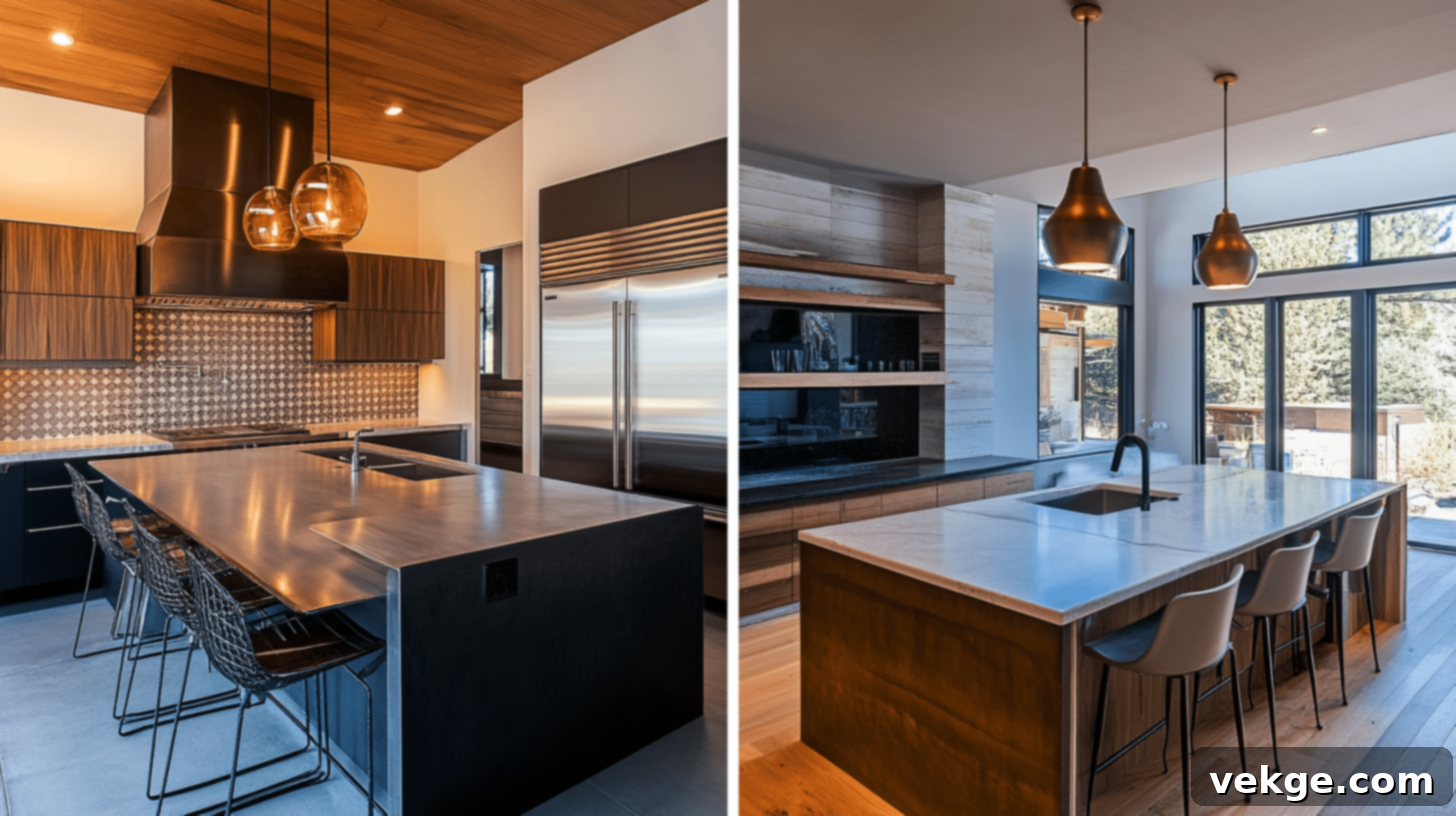Elevate Your Kitchen Design: The Ultimate Guide to Mixing Metal Finishes
In contemporary kitchen design, the trend of mixing metals has soared in popularity, and for excellent reason. This innovative approach moves beyond the limitations of a single, uniform finish, allowing for a far more dynamic and visually rich environment. As a design enthusiast, I’ve personally witnessed how the strategic combination of different metal elements can utterly transform a cooking space, imbuing it with layers of depth, character, and a unique personality that a monochromatic scheme simply cannot achieve.
This comprehensive guide is crafted to empower you with the knowledge and confidence to expertly blend various metal finishes in your own kitchen. You’ll gain invaluable insights into selecting complementary textures and tones, balancing diverse metallic elements, and seamlessly integrating mixed metals into your overall design vision. We’ll delve into my top tips for achieving visual harmony, ensuring every choice feels intentional and sophisticated, while also highlighting common pitfalls to avoid. Whether you’re embarking on a full-scale kitchen renovation or simply seeking to refresh your current space with stylish updates, I’ll equip you to confidently mix metals and create a truly personalized, show-stopping kitchen that you’ll adore for years to come.
Is Mixing Metals in Kitchen Design a Good Idea?
Absolutely, incorporating varied metal finishes into kitchen design is not just a passing fad but a sophisticated design strategy gaining significant traction. This method provides a refreshing departure from the traditional single-metal aesthetic, opening up a world of possibilities for creating unique and visually appealing culinary spaces. When executed thoughtfully, the careful combination of different metal elements results in a kitchen that radiates a bespoke, well-crafted, and truly one-of-a-kind ambiance. It grants homeowners unprecedented freedom to express their individual tastes and personality, enabling them to curate spaces that genuinely reflect their personal style and vision.
The beauty of mixed metals lies in their ability to add layers of visual interest and texture. Imagine the interplay of a cool, brushed nickel faucet with warm brass cabinet pulls, or a sleek stainless steel appliance suite accented by a rustic copper range hood. Each metal brings its own unique character, sheen, and history, creating a narrative within the space. This approach is particularly effective in transitional or eclectic kitchens, where the goal is to bridge different design eras or styles. However, the successful blending of metals demands meticulous planning and an eye for balance. The ultimate objective is to forge a cohesive look that appears intentional, refined, and perfectly harmonious rather than haphazard.
When mixed metals are employed correctly, they significantly enhance the overall aesthetic of a kitchen. They can make the space feel more inviting, luxurious, or even industrially chic, depending on your chosen combinations. This technique can also strategically highlight specific features, drawing attention to a striking light fixture or a beautiful piece of hardware. By embracing multiple metals, you’re not just decorating; you’re crafting an environment that is dynamic, attractive, and full of life, transforming your kitchen into a captivating heart of the home.
Top Metal Combinations for Your Kitchen
Exploring popular and effective metal combinations is key to mastering this design trend. Here are some of the most stunning pairings that designers love:
1. Stainless Steel and Brass
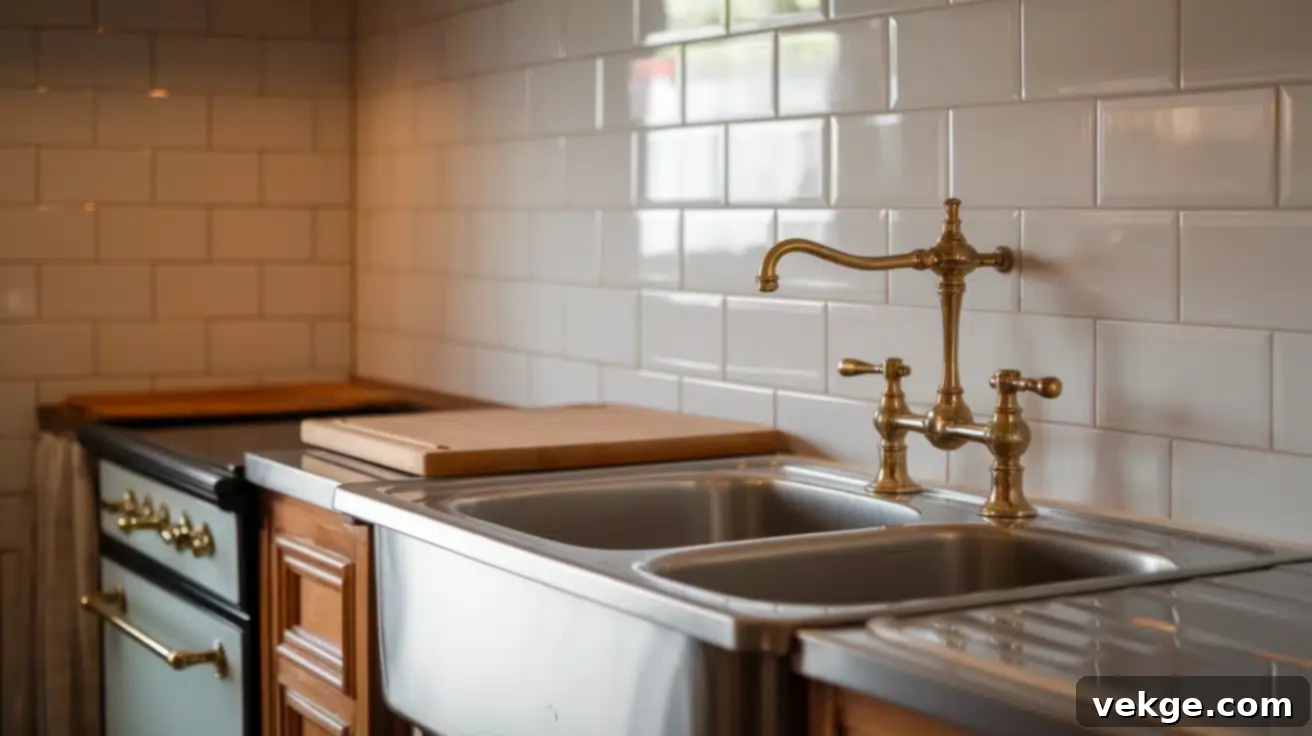
Stainless steel, with its cool, sleek, and often industrial appearance, creates a striking and beautiful contrast when paired with the warm, classic, and inviting glow of brass. This combination effortlessly marries modern functionality with traditional elegance, resulting in a perfectly balanced kitchen design that feels both current and timeless.
- Why It Works: The inherent contrast between the cool, steely undertones of stainless steel and the rich, golden warmth of brass creates a dynamic yet incredibly inviting atmosphere. Stainless steel often anchors the space with appliances, while brass adds sophisticated accents.
- Pro Tip: To prevent the space from feeling overwhelmed, use brass accents sparingly. Think brass pendant lights over an island, elegant cabinet hardware, or a vintage brass faucet to introduce warmth without overpowering the sleekness of stainless steel appliances.
2. Chrome and Copper
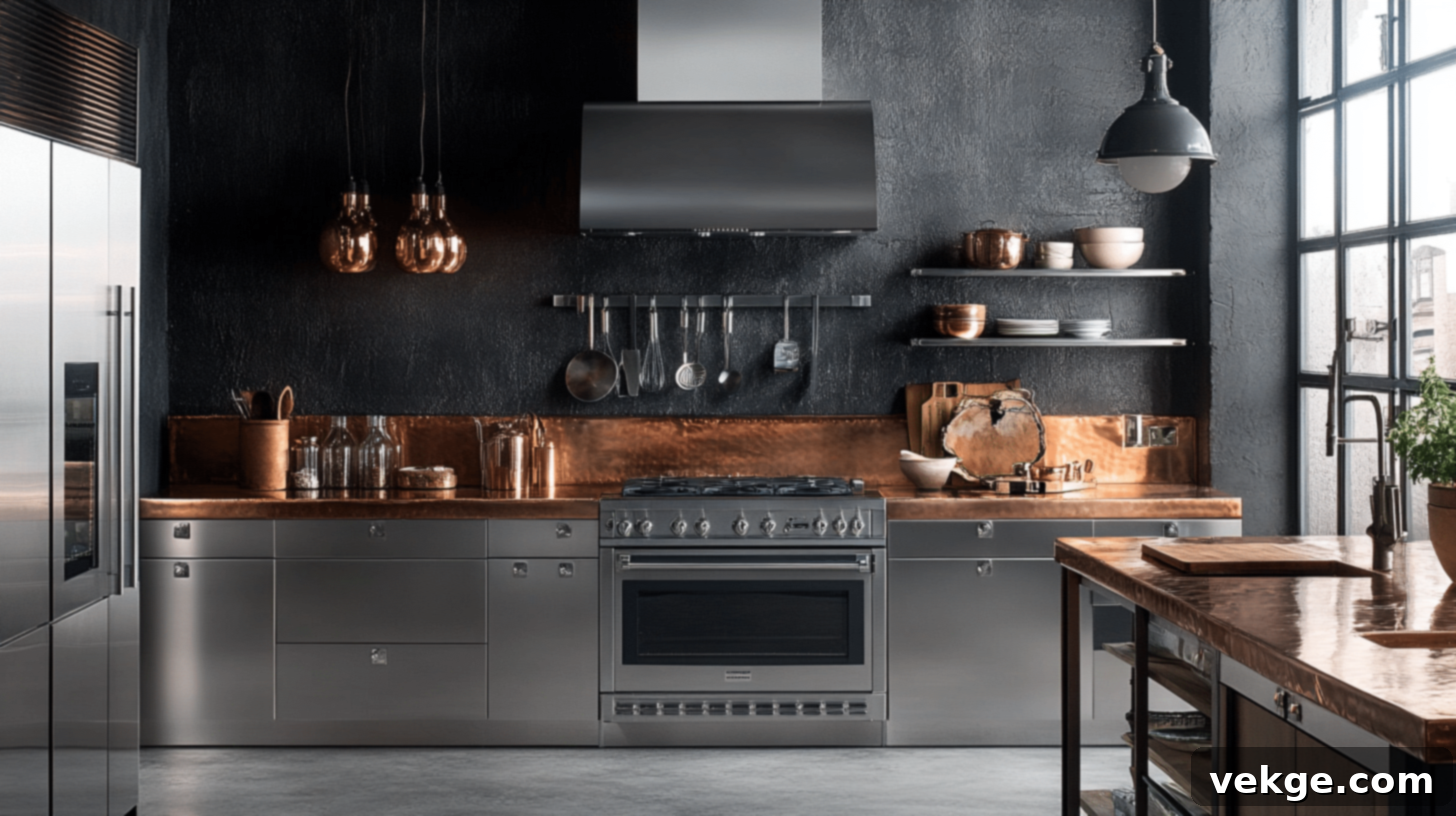
Chrome’s bright, highly reflective, and distinctly modern sheen finds a wonderful partner in copper’s rich, earthy, and often antique-like tones. This duo introduces a captivating touch of glamour and sophisticated shine, all while maintaining a welcoming and cozy feel within the kitchen.
- Why It Works: Both metals possess reflective qualities, but their distinct colors create a vibrant and lively kitchen. Chrome offers a clean, crisp brightness, while copper adds depth and a beautiful, living patina over time.
- Pro Tip: To balance the deep warmth of copper, especially if used for a range hood or cookware, consider pairing it with cool-toned countertops like marble or a light-colored backsplash. This ensures the kitchen feels airy and sophisticated.
3. Matte Black and Gold
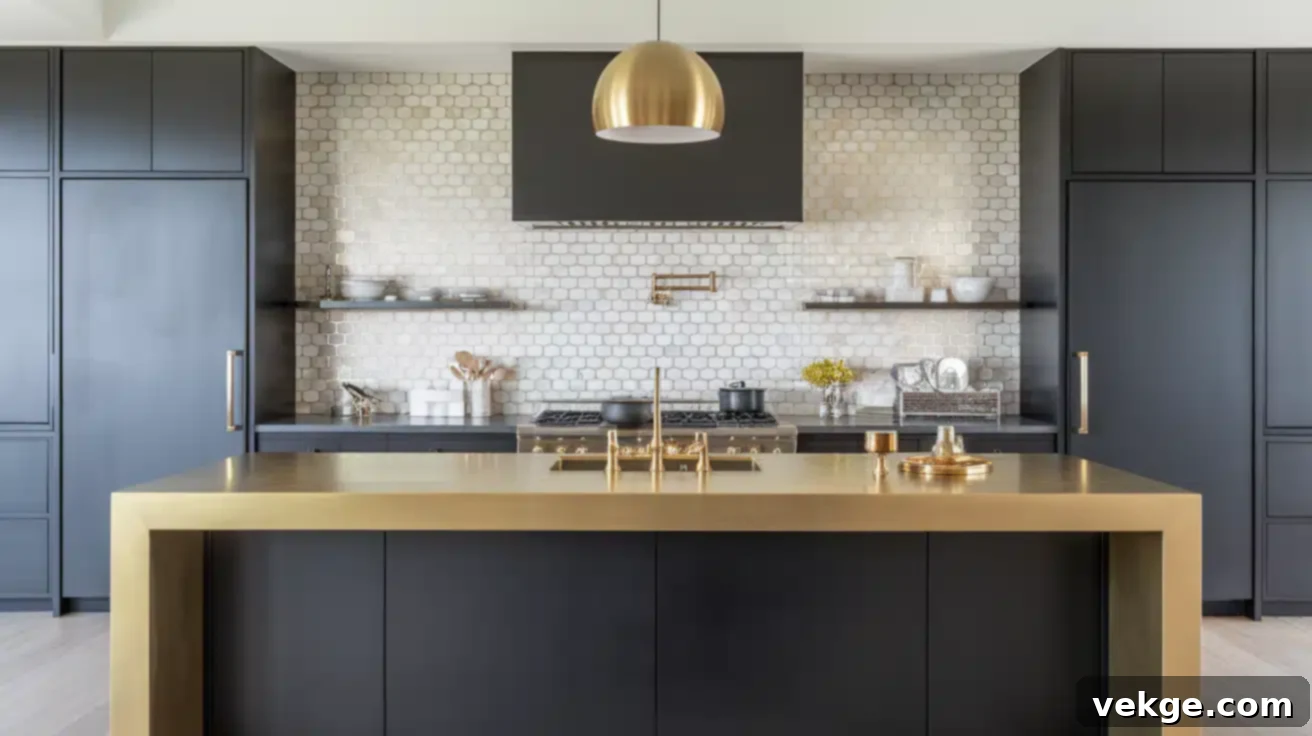
The bold, dramatic, and intensely contemporary look of matte black creates an unparalleled backdrop for the introduction of luxurious gold accents. This high-contrast combination delivers an impeccably polished and undeniably upscale aesthetic, making a powerful and memorable design statement in any modern kitchen.
- Why It Works: The stark contrast between the deep, non-reflective matte black and the radiant, opulent gold elevates the entire space. It creates a modern and luxurious atmosphere that feels both edgy and refined, perfect for a high-end look.
- Pro Tip: Use gold accents thoughtfully and strategically to achieve an elegant rather than a flashy appearance. Opt for gold in hardware, trim on lighting fixtures, or as a subtle inlay on cabinetry to add pops of warmth and luxury against the black.
4. Brushed Nickel and Bronze
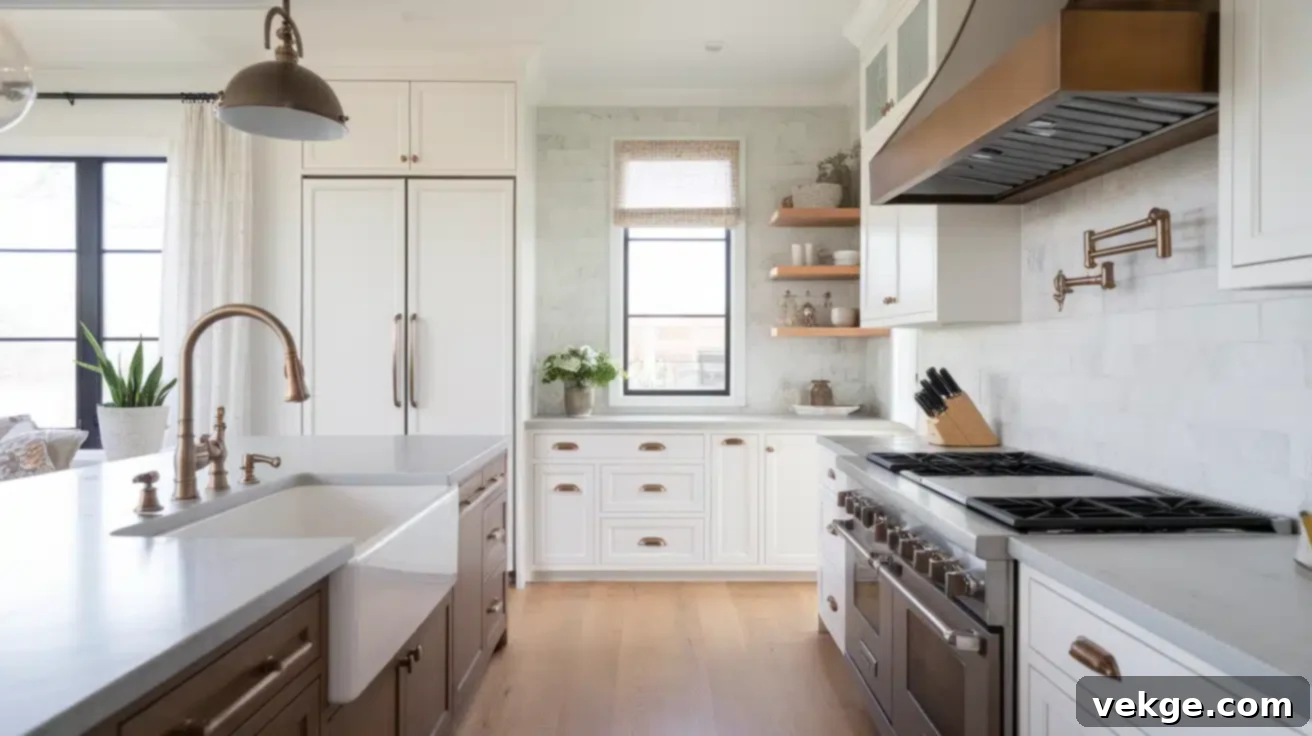
The subtle, versatile, and understated elegance of brushed nickel beautifully complements the warm, rich, and often rustic appeal of various bronze finishes. This pairing offers a seamless blend of modern sophistication and traditional charm, making it an ideal choice for transitional or farmhouse-style kitchens.
- Why It Works: The cool, muted tones of brushed nickel provide a calming counterpoint to the deep, earthy warmth of bronze. This mix adds remarkable depth and character, successfully balancing contemporary aesthetics with classic, inviting elements.
- Pro Tip: For optimal cohesion, strive to choose a bronze finish that shares a similar texture or sheen with your brushed nickel, such as an oil-rubbed or satin bronze. This subtle consistency helps maintain a unified and polished look across your metal elements.
5. Pewter and Silver
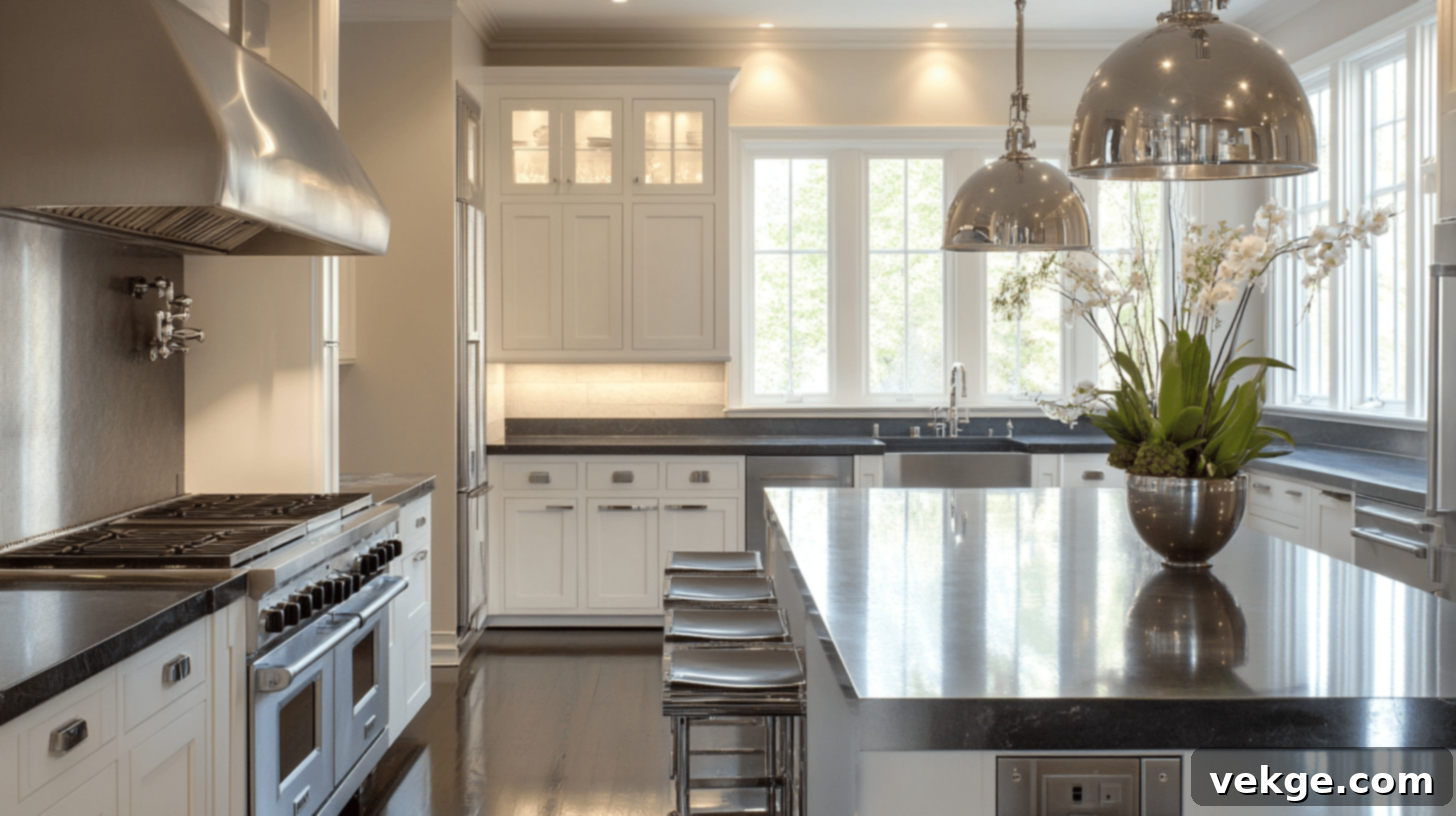
The soft, muted, and slightly antiqued character of pewter creates a beautiful harmony when combined with the bright, highly reflective, and sleek nature of silver finishes. This combination achieves a sophisticated, almost monochromatic look, distinguished by subtle yet engaging variations in tone and overall shine.
- Why It Works: The sophisticated interplay of pewter’s matte, understated finish and silver’s dazzling reflectivity brings remarkable dimension to the space. It adds visual interest and depth without ever overwhelming the kitchen’s overall design, perfect for a serene yet luxurious feel.
- Pro Tip: To prevent a flat or one-dimensional appearance within this subtle pairing, intentionally introduce texture through different finishes. Consider using a hammered pewter light fixture alongside polished silver hardware to create engaging contrasts and highlights.
6. Rose Gold and Brushed Steel
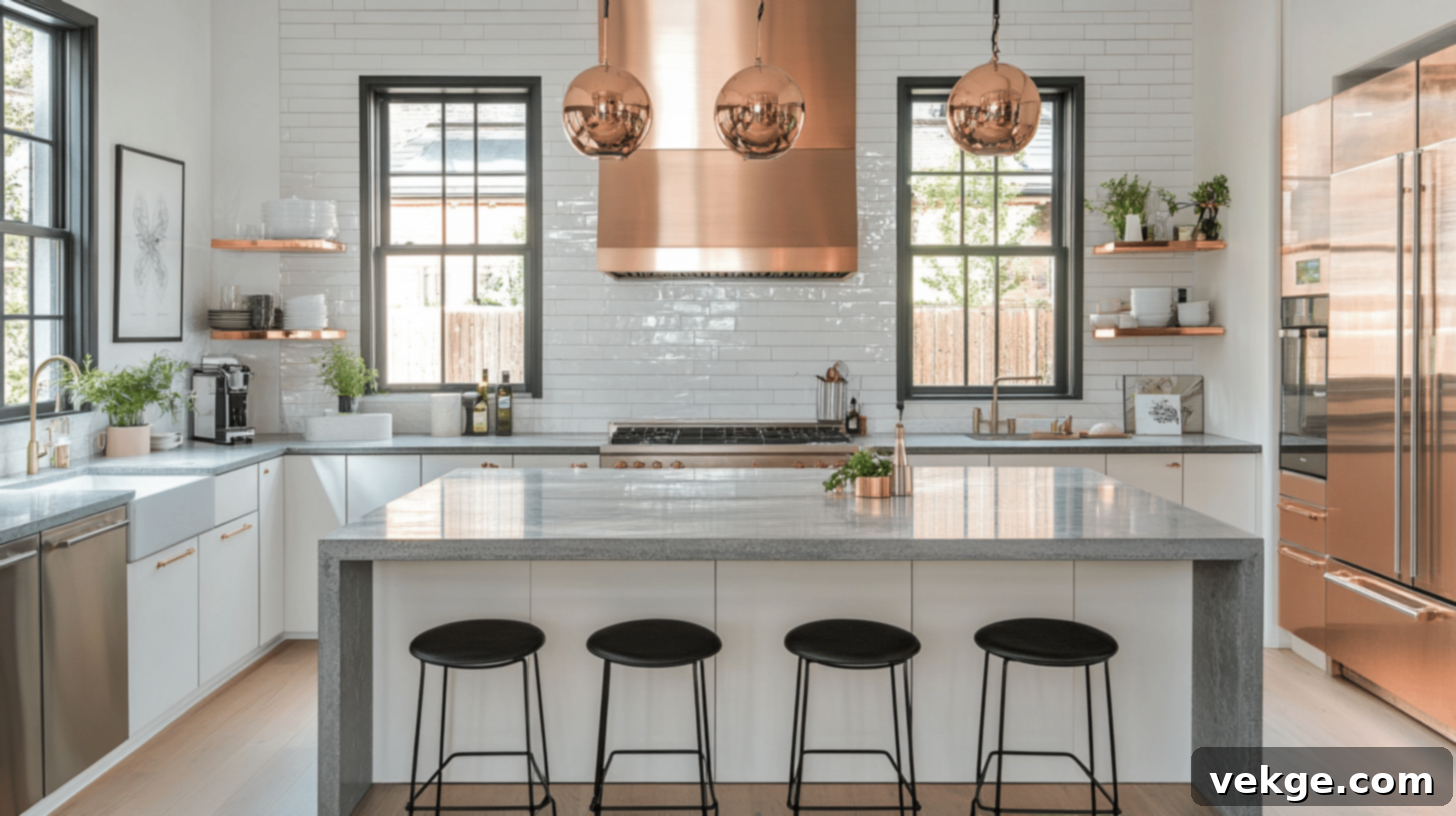
Rose gold, with its distinct warm, blush, and romantic tones, creates a captivating contrast against the cool, understated, and often industrial look of brushed steel. This combination effortlessly injects a touch of modern elegance and a subtle feminine charm into a contemporary kitchen design.
- Why It Works: The gentle, inviting warmth of rose gold acts as a perfect counterpoint, softening the more austere and industrial feel typically associated with brushed steel. This pairing feels sophisticated and modern without being cold.
- Pro Tip: Given rose gold’s unique and sometimes delicate hue, it’s best utilized for smaller, impactful accents. Think of stylish rose gold cabinet pulls, a single pendant light, or a statement faucet to add a touch of luxury without overwhelming the space.
7. Champagne Bronze and Stainless Steel
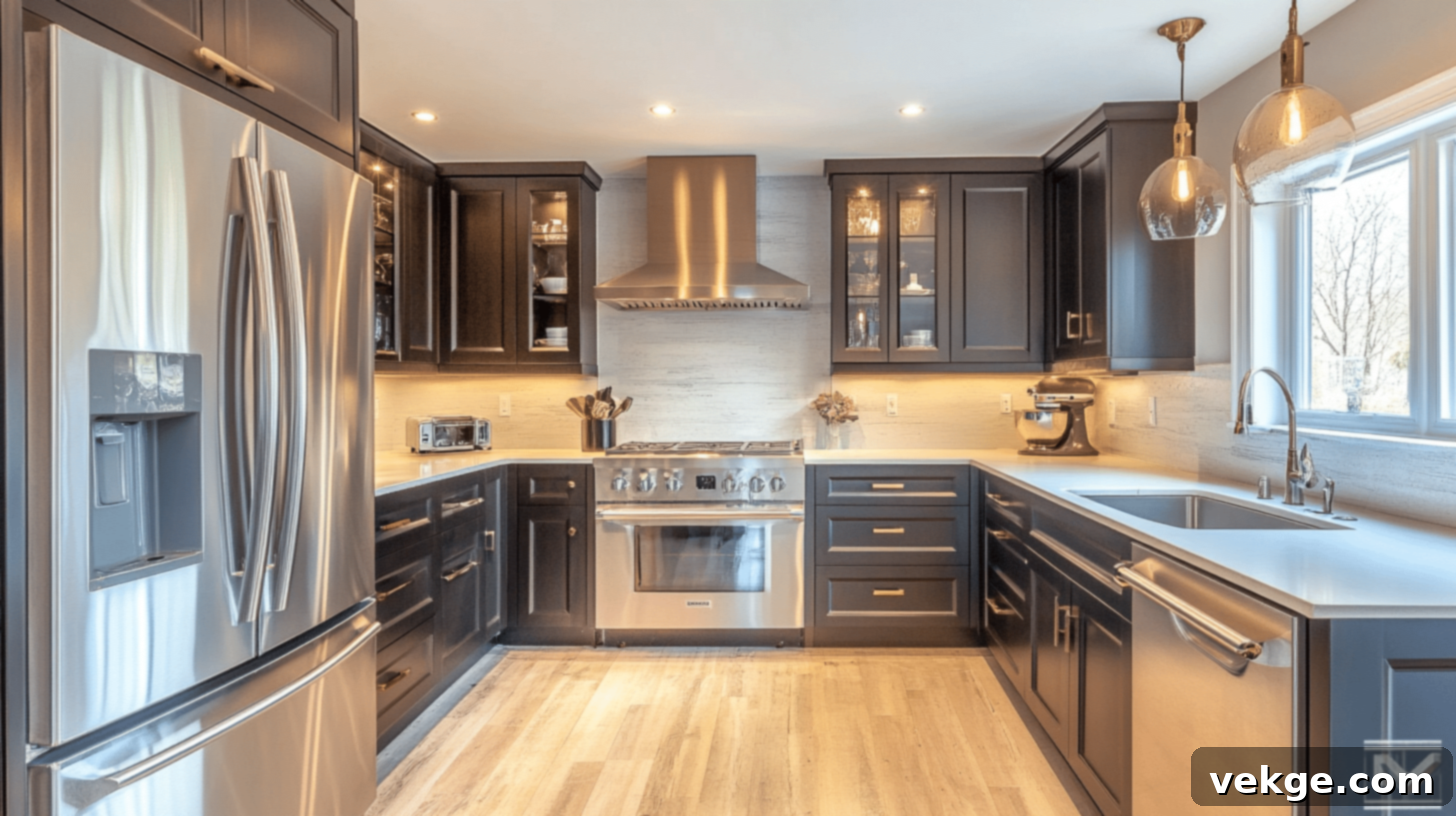
Champagne bronze offers a subtle, sophisticated warm glow that pairs exquisitely with the cool, sleek, and highly functional appearance of stainless steel. This refined combination works together to create an upscale, welcoming, and distinctly elegant kitchen atmosphere, perfect for a luxurious modern home.
- Why It Works: The nuanced warm undertones of champagne bronze masterfully soften the potentially clinical or purely functional feel of ubiquitous stainless steel appliances. It bridges the gap between warm and cool, creating a balanced and inviting space.
- Pro Tip: Leverage champagne bronze for decorative elements such as cabinet hardware, faucet fixtures, or even light fixtures. These accents provide essential warmth and a touch of sophistication that beautifully complements the larger stainless steel appliances, elevating the entire room.
8. Brass and Black
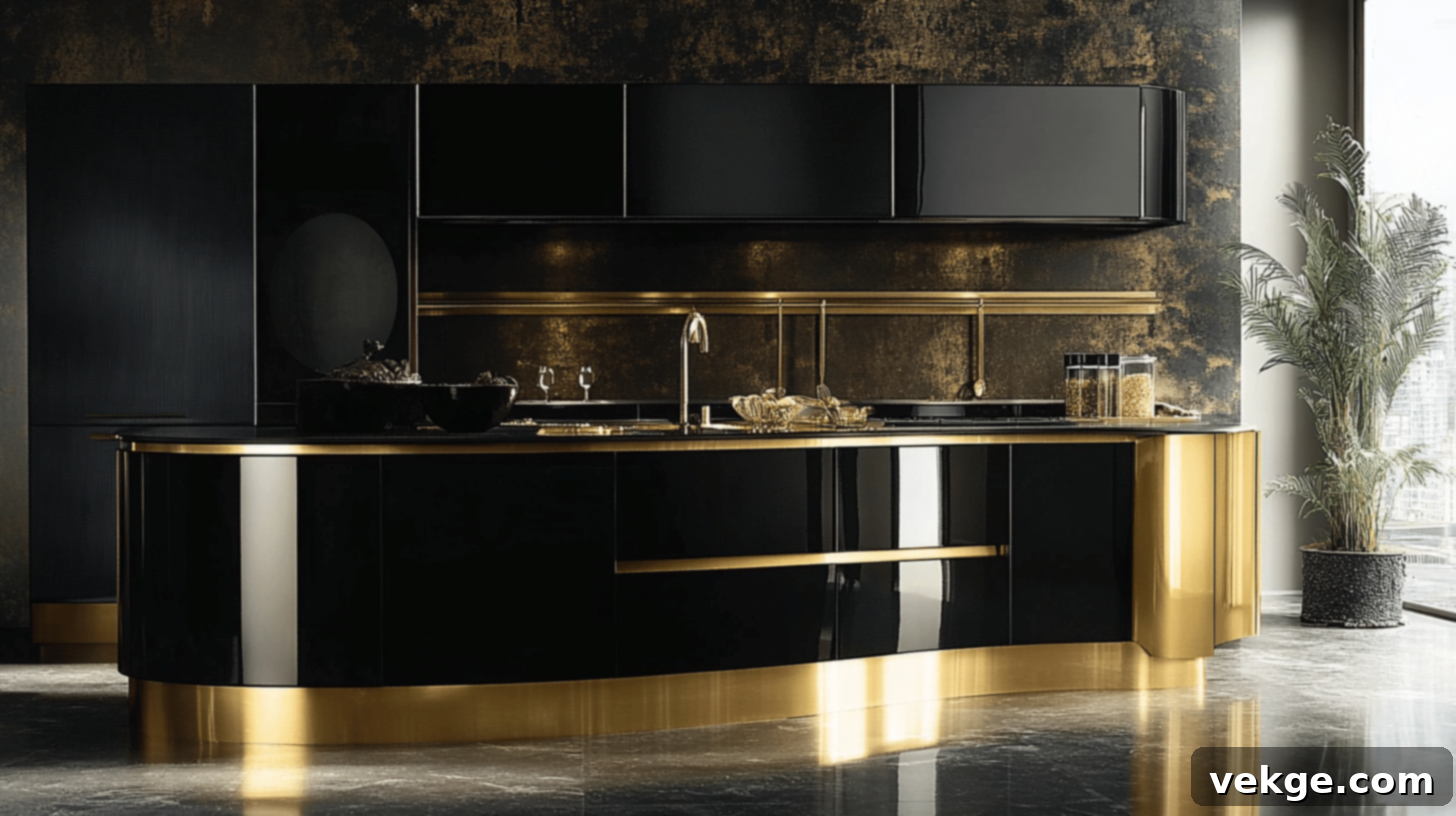
The radiant, warm, and golden tones of brass forge a stunning and luxurious contrast against the sleek, modern, and often dramatic presence of black elements. This striking combination instantly infuses a touch of high-end luxury and sophisticated drama into any contemporary kitchen design.
- Why It Works: The inherent warmth and luminosity of brass elegantly soften the boldness and depth of black. This creates a visually balanced and powerful look, where the gold provides a sophisticated highlight against the dramatic black backdrop.
- Pro Tip: For a truly modern and refined aesthetic, consider using black as your dominant color, perhaps for cabinetry, countertops, or a striking backsplash. Then, strategically introduce brass as elegant accents through hardware, statement lighting, or faucet fixtures to provide that desired pop of luxury.
9. Chrome and Brass
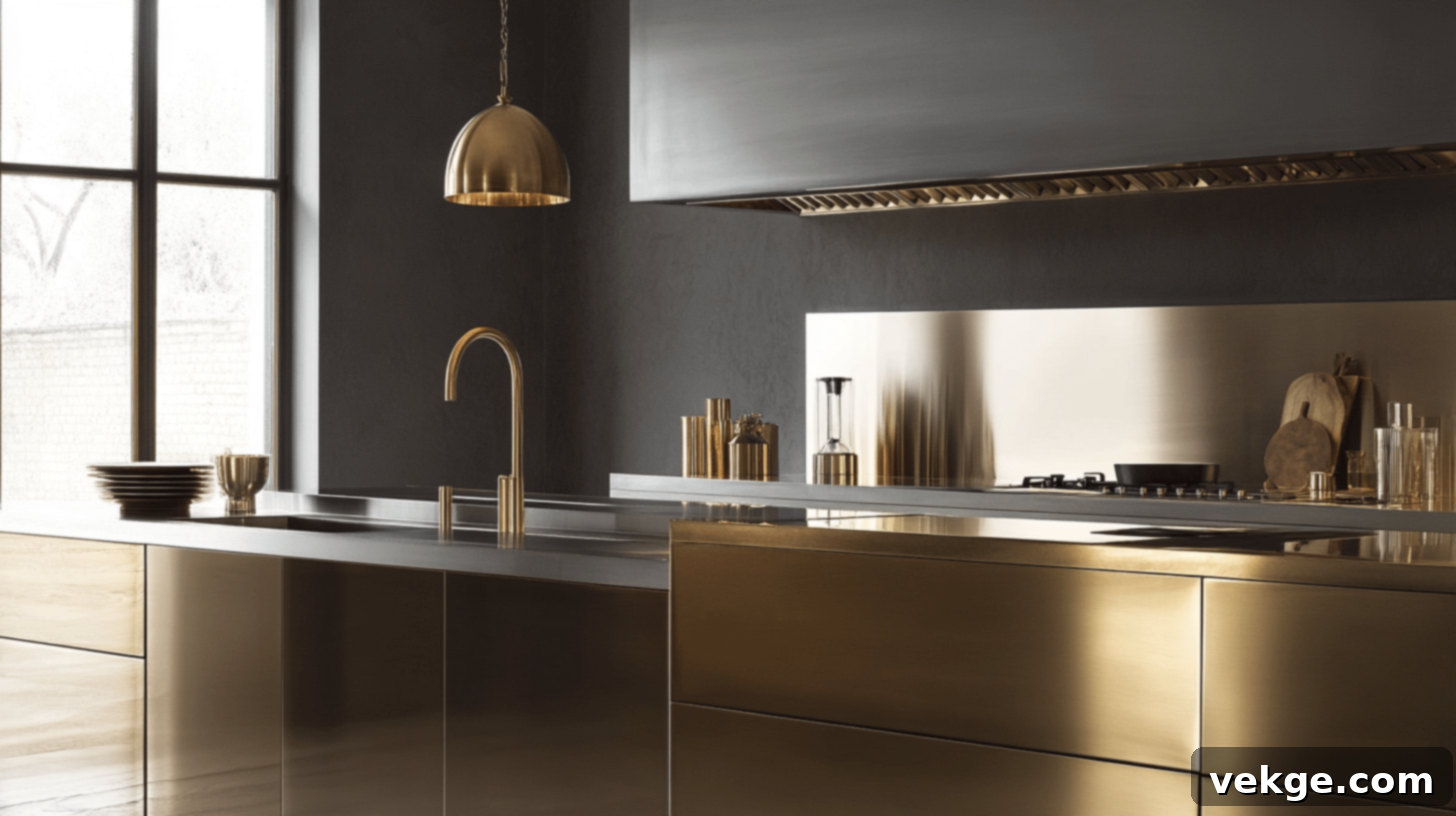
The cool, highly reflective surface of chrome beautifully pairs with the warm, rich, and inviting golden hues of brass. This classic yet contemporary combination successfully merges sleek, modern elements with timeless, traditional charm, resulting in a kitchen design that feels both fresh and enduringly elegant.
- Why It Works: The clear contrast between the crisp, cool reflectivity of chrome and the deep, warm luminosity of brass generates significant visual interest and adds layers of depth to the kitchen. It’s a versatile pairing that suits various styles.
- Pro Tip: To maintain an optimal visual balance, consider using chrome for larger, more functional surfaces like a primary faucet or appliance trim. Reserve brass for smaller, more decorative details such as cabinet pulls, decorative light fixtures, or a stylish range hood accent.
Expert Tips for Successfully Mixing Metals in Your Kitchen
Achieving a cohesive and stylish mixed-metal look requires thoughtful planning. Here are some expert guidelines to help you navigate the process:
- Choose a Dominant Metal and Limit Your Palette: To prevent your kitchen from looking cluttered or chaotic, select one metal as your primary finish. This dominant metal should be used for the largest elements, such as major appliances or the main faucet. Then, limit your accent metals to just two or three additional finishes. This creates a clear foundation and allows the secondary metals to act as intentional accents, adding interest without overwhelming the space.
- Consider Undertones and Finishes: Pay close attention to the inherent undertones of the metals you choose. Group metals with similar undertones (e.g., warm metals like brass, gold, and copper; or cool metals like stainless steel, chrome, and nickel) to ensure they complement each other. Additionally, play with different finishes – combining polished and matte, or brushed and hammered, can add significant visual interest and texture. However, if you prefer a more unified and seamless look, matching finishes across different metals (e.g., brushed brass with brushed nickel) can create refined cohesion.
- Create Balance and Distribution: Effective metal mixing is all about thoughtful distribution. Avoid clustering too much of one metal in a single area. Instead, spread your chosen metal finishes evenly throughout the space. For example, if your island pendant lights are brass, ensure there are other brass elements like cabinet pulls or a pot filler elsewhere in the kitchen. Also, remember that lighting conditions can dramatically affect how metals appear, so consider how natural and artificial light will interact with your chosen finishes.
- Coordinate with Overall Kitchen Style and Materials: Your metal choices should always enhance, not clash with, your kitchen’s overarching design theme. For instance, rustic or farmhouse kitchens often benefit from warmer metals like copper, oil-rubbed bronze, or aged brass. Conversely, sleek, modern, or minimalist spaces pair beautifully with cool metals like polished chrome, stainless steel, or matte black. Ensure your chosen metals also work harmoniously with other prominent materials in your kitchen, such as your countertops, backsplash tiles, and cabinetry.
- Start Small and Maintain Consistency: If you’re new to mixing metals or feeling hesitant, begin with small, low-commitment changes. Swapping out cabinet pulls, updating light fixtures, or choosing a new faucet are great starting points. Once you’ve established your primary and accent metals, strive for consistency within certain categories. For example, use the same metal finish for all cabinet hardware on a specific run of cabinets. Similarly, consider keeping your main kitchen faucet and sink finishes matching for a truly cohesive and polished look, then introducing your accent metals through other elements.
- Remember Practicality: Beyond aesthetics, the practical aspects of your metal choices are crucial. Consider the durability of different metals and how well they will stand up to daily use in a busy kitchen environment. Research their maintenance requirements – some metals, like polished brass, may require more frequent cleaning to maintain their shine, while brushed finishes are more forgiving. Also, think about how certain metals, such as copper or unlacquered brass, will naturally age and develop a patina over time. Ensure your selections align with your lifestyle and cleaning preferences to guarantee long-term satisfaction.
By diligently following these expert guidelines, you can confidently create a well-balanced, visually appealing, and highly functional kitchen design that masterfully incorporates the elegance of mixed metals.
Metals to Avoid Mixing: Maintaining Harmony in Your Kitchen
While mixing metals offers creative freedom, some combinations can create a disjointed or clashing appearance. Here’s a quick guide to pairings that are generally best avoided to maintain a harmonious kitchen aesthetic:
| Metal 1 | Metal 2 | Reason to Avoid |
|---|---|---|
| Copper | Stainless Steel | These have strongly clashing undertones; copper’s deep, warm, and rustic appeal often makes the cool, contemporary stainless steel look stark or clinical, disrupting visual balance. |
| Polished Brass | Satin Nickel | The bright, often opulent shine of polished brass can easily overpower the subtle, muted elegance of satin nickel. This pairing tends to look unintentional rather than thoughtfully curated. |
| Oil-Rubbed Bronze | Chrome | The stark contrast between the very dark, matte, and often rustic oil-rubbed bronze and the brilliant, highly reflective chrome is usually too jarring. It can make the kitchen appear disjointed and visually uncomfortable. |
| Rose Gold | Yellow Gold | While similar in their warm family, the distinct pinkish hue of rose gold and the classic yellow tone of traditional gold are often just different enough to clash. This can create a messy, cluttered, or indecisive look rather than a sophisticated blend. |
| Matte Black | Polished Silver | The deep, non-reflective modernity of matte black provides a jarring contrast with the bright, traditional gleam of polished silver. This clash often highlights the difference between modern and classic styles in a way that feels unharmonious. |
Tips to Incorporate Mixed Metals on a Budget
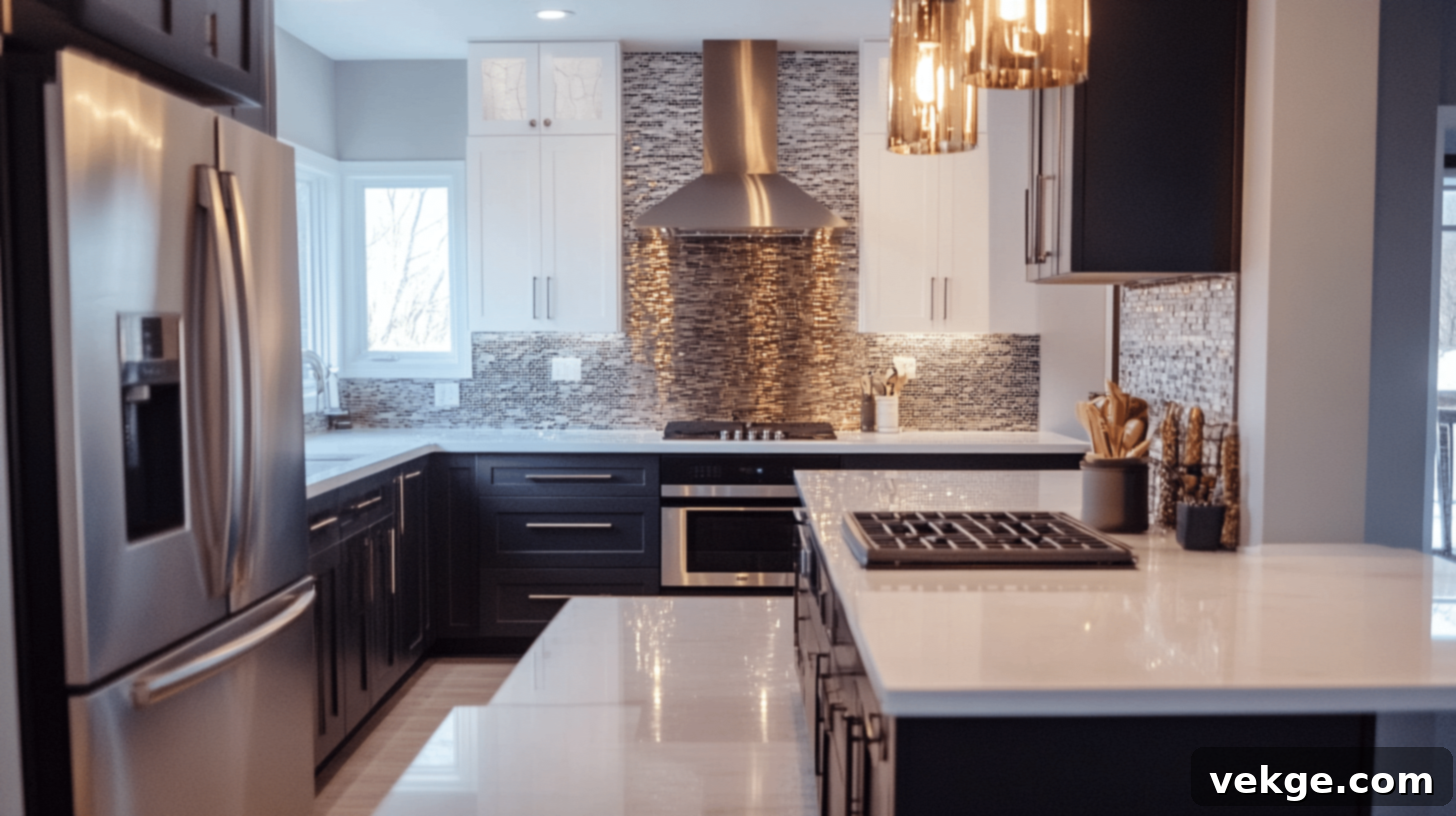
Achieving a stylish mixed-metal kitchen doesn’t have to break the bank. Here are several cost-effective strategies to introduce this trend into your home without a hefty investment:
- Start with Small Changes: The most budget-friendly way to begin is by replacing inexpensive, easily swappable items. Think about upgrading cabinet hardware, such as knobs and pulls, with a different metal finish. Look for sales, clearance items, or purchase in bulk to save even more money on these small but impactful details.
- Utilize Spray Paint for Existing Fixtures: Give old fixtures, decor items, or even furniture pieces a metallic makeover with high-quality metallic spray paint. This offers a remarkably cost-effective way to transform existing elements, allowing you to experiment with different metallic finishes like gold, copper, or bronze without buying new items.
- Shop Secondhand for Unique Accents: Thrift stores, antique shops, flea markets, and online marketplaces (like Etsy or Facebook Marketplace) are treasure troves for unique and affordable metal accents. You can find vintage trays, decorative bowls, picture frames, or even small lamps with beautiful metal finishes that add character and warmth.
- Try Metallic Contact Paper or Peel-and-Stick Tiles: For an affordable and temporary metallic touch, consider using metallic contact paper or peel-and-stick tiles. These can be applied to backsplashes, appliance panels, or even the inside of open shelving for a striking visual pop that mimics the look of real metal.
- Opt for Metal-Look Materials: Many manufacturers offer materials that convincingly mimic the appearance of genuine metals at a fraction of the cost. Look for items like light fixtures, decorative screens, or even wallpaper with metallic prints that provide the desired aesthetic without the premium price tag.
- Focus on One Statement Piece: Instead of spreading a small budget across many items, invest in one significant statement piece in your chosen accent metal. A beautiful copper pendant light over the dining area, a luxurious gold-toned faucet, or a striking matte black range hood can effectively tie the mixed-metal look together and serve as a focal point.
- DIY Decor with Inexpensive Materials: Get creative and craft your own metallic touches. Projects like wrapping picture frames with metal leaf, creating geometric wall art using metallic paint, or repurposing items with metal spray paint can result in unique, personalized decor that adds metallic flair on a very limited budget.
By implementing these clever strategies, you can successfully incorporate mixed metals into your kitchen design on a budget, achieving a sophisticated and stylish look that appears far more expensive than it actually was.
Wrapping It Up
As we conclude this comprehensive guide on mixing metals in kitchen design, I genuinely hope you’re feeling inspired and equipped to embrace this stylish trend within your own space. Remember, the true artistry lies in striking a harmonious balance between your chosen metals, always considering the overarching style and existing materials of your kitchen. Don’t be afraid to start small – even subtle changes can make a significant impact and allow you to build confidence in your design choices.
Whether your vision involves the sleek sophistication of stainless steel paired with classic brass, or the dramatic luxury of matte black accented by gleaming gold, the possibilities for creating a unique and personalized kitchen are truly endless. I’ve shared my expert tips, highlighted favorite combinations, and even provided practical advice for budget-conscious updates, but now the canvas is yours to fill.
I am always eager to see how you incorporate mixed metals into your kitchen designs – please feel free to share your creative projects or reach out with any questions you might have. With a little careful planning, a dash of design courage, and the insights gained from this guide, you are well on your way to crafting a kitchen that is not only uniquely yours but also beautifully balanced and exquisitely stylish. Happy designing!
Frequently Asked Questions
Can You Mix Warm and Cool Metals in The Kitchen?
Yes, absolutely! Mixing warm (like brass, copper, gold) and cool (like stainless steel, chrome, nickel) metals is not only permissible but often encouraged for adding depth and visual interest. The key to success is to choose one dominant metal (e.g., cool stainless steel for appliances) and use the other as a thoughtful accent (e.g., warm brass for hardware or lighting). Ensure both metal types are distributed evenly throughout the space to create a balanced and intentional look rather than a disjointed one.
How Many Metal Finishes Should I Use?
For a cohesive and well-designed kitchen, it’s generally best to limit your palette to two or three distinct metal finishes. Using too many (four or more) can make the space feel cluttered, uncoordinated, and visually overwhelming. Select a main, foundational finish for larger elements, and then choose one or two complementary finishes for accents like hardware, lighting, or decorative pieces. This approach maintains elegance and focus.
Can I Mix Chrome and Stainless Steel?
Yes, you can certainly mix chrome and stainless steel. They are both cool-toned metals, making them natural companions in a kitchen setting. While stainless steel typically has a brushed or matte finish and a slightly warmer grey tone, chrome is known for its brighter, more reflective, and often bluish sheen. Their subtle differences in appearance and texture work well together, creating interest without clashing, and are perfect for a sleek, contemporary aesthetic.
Should Cabinet Hardware Match Kitchen Faucets?
No, your cabinet hardware does not need to match your kitchen faucets exactly. In fact, intentionally choosing different finishes can add a layer of sophistication and depth to your kitchen design, which is a core principle of mixed metals. The most important thing is that these elements complement each other. You can use different finishes as long as they share similar undertones (both warm or both cool) or align with the overall style of your kitchen. For instance, a matte black faucet could pair beautifully with brushed brass cabinet pulls, as both bring a modern elegance to the space.
